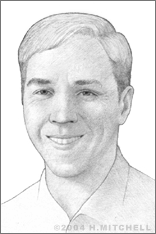Jeff Hawkins
The ubiquitous handheld organizer known as the PalmPilot was first conceived in 1992. Its inventor, Jeff Hawkins, initially set out to conduct research related to the function of the human brain. He was interested in the ways in which the brain acquires and stores information, which, in essence, develops intelligence. His creation of the world’s most popular personal digital assistant grew out of his interest in this field and has since launched an entire new industry.
Hawkins was born in Long Island, New York on June 1, 1957. His father was a natural tinkerer and boating enthusiast. With the help of his sons, he built a floating structure that they called the “Sea Space,” a type of displacement boat that had built-in legs that could be lowered onshore to create a platform. They sold it to the Waterways Orchestra, which used it to travel and hold concerts. The experience that Hawkins gained in building and design with his family sharpened his interest in math, physics, and engineering. He decided to pursue electronic engineering in college, earning his BSEE from Cornell University in 1979.
After working for Intel for a few years, Hawkins joined GriD Systems in Silicon Valley, which was focused on designing and building portable computers, mainly for business use. He believed it was possible to go further than that by developing a computer that would respond to human impulses. He decided to head back to school to pursue research in “brain mapping,” enrolling in U.C. Berkeley’s graduate program in biophysics in 1986. Two years later, he left the program before completing his degree and patented “PalmPrint,” an algorithm for handwriting-recognition software. He licensed it to GriD, where he became vice president of research.
At GriD, Hawkins and his team developed the GriDPad, the first successful pen-based computer. It was large and awkward, but it worked. All the while, his mind was churning with ideas for employing this technology in very small, portable, general purpose computers. He left GriD in 1992 to launch his own company, taking a license for his software with him. He secured venture funding and hired Bill Campbell, the company's first CEO, and Donna Dubinsky, who helped him create a strategic plan. Thus, Palm Computing was born.
At the time, several technology companies were working on handheld computers, namely Apple, who first came up with the term “personal digital assistant,” or PDA. Palm Computing’s first device, the Zoomer, was a failure. It was expensive, slow, and had inefficient text recognition. The company reconsidered its strategy. Its next product, dubbed the Pilot, would be a legendary success.
Small enough to fit in a shirt pocket, the Pilot included a calendar, task list feature, memo-writing ability, and address book. It was reasonably priced at less than $300. But most importantly, it employed Hawkins’ newly perfected handwriting recognition software, Graffiti, which set Palm’s products apart from all the others on the market. Graffiti was seen as somewhat of a risky proposition because it made it necessary for users to learn how to write differently, in a way that the computer would understand. It proved to be easy to master. The first units shipped in the spring of 1996. More than one million devices were sold within the first 18 months.
The Pilot soon became the PalmPilot, and improved versions followed with even greater success. Palm Computing became a division of U.S. Robotics. 3Com acquired U.S. Robotics in 1997, but the companies separated again in 2000, and Palm, Inc. spun off from 3Com later that year as an independent company.
Hawkins and Dubinsky founded Handspring in 1998, launching the uber-successful Handspring Visor in 1999. Palm acquired Handspring in 2003 and combined its palmSource and palmOne divisions under one publicly traded entity, palmOne, Inc. In 2005, Hawkins co-founded Numenta, together again with Donna Dubinksy, who holds the position as CEO. Numenta, based in Redwood City, Calif., is building computer memory systems based on the principles of how neurons in the brain work.


